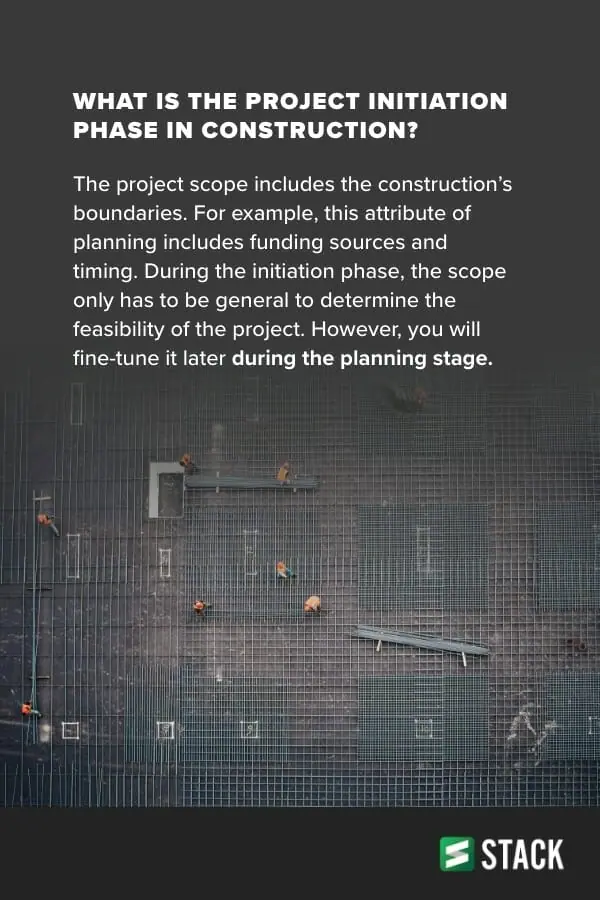
A construction project will undergo several stages before groundbreaking. Understanding exactly what happens at each stage will ensure the project does not miss vital steps. From project managers to project subcontractors, it’s important for those in the industry to learn about every phase of construction — even the ones they don’t directly take part in — so they have a better understanding of their role in the project.
Executing a construction project requires five essential phases. Many people don’t see the extensive planning and research that occurs before a project begins on the site. Within each phase are smaller steps the project management team must make to ensure the project will be profitable. By undergoing thorough planning, the management team can also take the time needed to assess every aspect of the project and identify how to balance cost and quality.
A construction management plan (CMP) can refer to one of three types of documents — overall, detailed or impact CMPs. The most common plans are detailed ones. However, knowing what the other two types include is also important.
- Overall CMP: An overall CMP is used to generate goals for the project at a high level. These types of CMPs are not for project managers to determine schedules or find contractors. However, they are good for outlining the basics of the project for people outside the industry to reference.
- Detailed CMP: A detailed CMP includes all of the information needed for planning, scheduling, funding and executing each step of the project. This tool is essential for contractors to stay on schedule and keep the project working as close to the budget as possible. Some cities, such as Portland, Maine, require a detailed CMP as an addition to the site review plan to gain approval for the construction project to begin.
- Impact CMP: Some municipalities may also require an impact CMP. This type of plan shows how the construction work and finished project will affect the surrounding area.

Since a detailed CMP is the most common, it includes all of the aspects of the project, which fall into the following categories:
- Scope: What is the purpose of the project?
- Schedule: How long will the project last? What are the main milestones during the process?
- Budget: How much will the project cost? What is the best way to prevent overspending? Where can some costs be cut?
- Resources: Who are the best subcontractors to complete the project? What is the best way to find them?
- Procurement: What materials are necessary for the project? What logistics processes can ensure they fit the project’s budget and arrive on time?
- Quality: What codes does the building need to meet during construction? How will the construction team meet or exceed those requirements?
- Risk: What risks are present in the project’s completion? How can subcontractors and safety personnel mitigate or respond to future risks?
- Communications: Who is on a “need-to-know” basis about the project and at which steps? What is the most efficient method of communicating with them?
- Change: What will happen when the project must undergo changes? If natural disasters or other external issues put construction off schedule and over budget, what steps can be taken to get back on track? Is there a backup plan?
The above components of a detailed CMP ensure an adequate outline for every essential portion of the process, which will reduce problems during the building phase of the work.
The stages of planning start with a feasibility project assessment and include planning the details of the construction, executing the work, measuring progress and completing the project. Within each stage, it’s crucial to have multiple consultations with others involved in the project before progressing to the next stage. The best way to avoid issues in the later stages of construction work is to lay the groundwork during the initiating and planning portions of the project.

Before breaking ground or creating a single plan, it’s crucial to evaluate whether a project can and should be completed. The initiating stage determines the feasibility of a construction project. During this portion of the project, a project manager is not yet named, nor is the funding acquired. Instead, questions of whether to create a construction project are identified and addressed.
The initiation phase involves determining whether the construction project is realistic and feasible. In this phase, those involved in project planning need to identify major issues that could prevent construction, the project’s goals and its scope. An example of issues that could prevent construction is if a building does not fulfill a need for an area, it may not be profitable to construct.
While most of this portion of the construction phase involves ideas and paperwork, it can be one of the most important steps in the entire process. Not taking the time to thoroughly examine the feasibility of the project can result in unanticipated issues that can halt work. In extreme cases, these problems might require the team to completely start over. If the planning team does not thoroughly examine the project’s feasibility, the possibility of unexpected concerns arising during construction increases.
The project’s goals are integral to honing the process to its most specific aim. For instance, instead of determining to only construct commercial real estate, decide the type — will the structure be an office building, a shopping center or a restaurant? Goals for the project need to be measurable, time-constrained and specific.
The project scope includes the construction’s boundaries. For example, this attribute of planning includes funding sources and timing. During the initiation phase, the scope only has to be general to determine the feasibility of the project. Fine-tuning comes later, during the planning stage.

The main work of the initiation phase includes market studies and feasibility studies. Both studies are helpful in deciding whether proceeding with the construction project in the area will be beneficial to a company and those in the area.
Market studies look at whether the area needs the type of building proposed. For instance, market studies that show growing suburbs may indicate the need for restaurants and some commercial real estate, such as shops within the area. On the other hand, the market would likely not show demand for homes in a heavy industrial area that instead requires more factories or warehouses.
Feasibility studies decide if the construction of a certain type of building is possible. For instance, zoning laws may prohibit certain types of construction in some cities. Protected wildlife areas next to construction sites may make the building process difficult due to restrictions on vehicular traffic in the area.
These market and feasibility studies are based on the goals and scope of the project. The result of the initiation phase is a project charter, which proposes the project’s general budget and timeline to stakeholders, who approve or deny the project before more extensive planning begins.

The initiation phase should include the project manager or have the project sponsor name a manager. The manager and sponsor should work to specify the goals and scope of the project and assign teams to conduct market and feasibility studies. During this phase, the management team identifies stakeholders in the project who must approve the charter to ensure the construction work will have adequate funds.
The planning portion of the construction project is even more crucial to the success of the structure than the initiation phase. The ultimate goal of this stage is to make enough decisions and arrangements to complete a detailed CMP. It includes everything from budgeting and scheduling to determining who will contribute to the construction. Take extra time to verify every decision made during this phase to ensure the execution is more likely to stay under budget and on time.
During the planning phase, it’s important to determine everything that must be done to complete construction. The team will need to outline what specific tasks need to happen, who will complete them and how they will find these people. For instance, if subcontractors will be necessary for plumbing installation on the project, how will contractors take bids from them? And what makes these subcontractors the right ones to do the job?
Planning requires deep involvement in creating a budget. The project manager may take bids from subcontractors to see who can meet the budgetary needs of the project. These cost estimates for the labor and materials from subcontractors are only small components of the budget. Other equipment, materials and labor from the general contractor also go into the budget, alongside fees for permits, inspections and other legal requirements.
A robust software solution can help manage multiple bids and facilitate budget development for the project to reduce wasted time. Contractors may also use construction software for speeding up their takeoff process and shoring up bids faster. The schedule for the project is an additional area in which software plays an important role. Scheduling helps ensure the construction remains within the project scope and has a reasonable amount of time for completion.
Quality planning is another aspect of this stage. The quality plan should include information about the quality expected from the construction, how the project will achieve that and how the project manager will verify the quality along the way. Because high quality can increase costs, the project manager must carefully balance the quality with the budget when creating both plans. The quality plan helps ensure the final occupant of the structure is satisfied with the construction work.

The project manager takes charge of much of the work of the planning phase. However, they will likely use software to help establish budgets and schedules and get advice and bids from others on the project team. Approval for the finalized budget and schedule may be required from the stakeholders of the project.
This stage aims to create a finished, finalized outline of exactly what needs to be done during the execution and completion phases to finish the project. A completed, detailed CMP and quality plan are both essential products of this stage. Once these parts are finished, the project can proceed to the execution phase.
The execution phase, also known as the implementation phase, should follow carefully the schedule and budget created during the planning stage. If planning produced a thorough, clear CMP, the actual construction should happen with few issues.
Communication among teams working on the project is essential during this phase to ensure everyone stays within the project’s plan. Having cloud-based plans and documents instead of paper files makes the communication process simple during meetings at the worksite on a mobile device or in an office on a desktop computer. Improved communication avoids problems with misunderstandings that could cause delays.

Those involved in the execution of the construction project include team leaders, construction managers, the project manager and others directly involved with the construction. These people need to connect frequently throughout the process to measure progress, create status reports for stakeholders and make changes to the schedule or plan if required.
Measuring progress takes place during the execution phase of the construction progress. Since changes can shift the work schedule, constant monitoring of the process is important for identifying when and if to make schedule changes to ensure the work finishes on time and within the budget. A key component of comparing progress to the original detailed CMP is to have a copy available on the job site that everyone uses. Cloud storage ensures everyone can access the most updated records.
The work in progress should go through daily assessments and monitoring to see how well it aligns with the existing plan for the project. Meetings among project managers, construction managers and team leaders can ensure that those doing the physical work are following the plan created during the planning stage. When collecting information about the construction progress, the project manager should compare it to established metrics to see how close the project will finish on time and within its budget.

Monitoring construction work progress needs to be a daily task for construction managers. However, the specific metrics used will differ for each project. The quality plans and detailed CMP will guide the project manager in the specific attributes that will indicate progress. Another way to think of these metrics is as key performance indicators (KPI). These metrics may also go by the term milestones.
Each aspect of the construction will have different KPIs:
- Budget KPIs: Focus on the amount of money spent during the process on equipment, labor and materials to see how close the actual spending is to the created budget
- Overall performance KPIs: Look at whether specific stages of the construction have happened on time
- Quality KPIs: Use the established assessment measures from the planning stage to determine if the quality of completed work meets the stated requirements
- Objective KPIs: Look at the project overall and how closely the construction stays within scope, schedule and budget

Project tracking software can help project managers compare work to the KPIs or original plan. How can project managers and supervisors use it to measure progress and complete a construction project? A good software program allows team members to easily view updated plans and create reports needed to outline progress. Progress tracking software stores and allows the user to organize documents in the cloud for access from anywhere. These documents become essential when closing out the project.
Project tracking software keeps tabs on how close the project comes to completion by giving the project manager a quick view of the original plans and existing reports. By integrating this software with customer resource management (CRM) solutions, the stakeholders can have quick access to the status reports, alleviating concerns they may have about the project. Other integrations make connecting construction project budgets with company accounting fast and simple.
Software solutions that feature integrations allow for better handling of all the documentation that comes with managing a construction project. Plus, with programs like STACK, project managers can handle everything from the initiation phase through the closure of a project from anywhere. Using software to reduce wasted time and speed up work will set up a construction company for success.
At the completion of the construction phase, inspections occur to ensure the project meets local requirements. The project manager finalizes the close of the project and turns over documentation to the client. They must also close out all supplier contracts, release resources used during the project and communicate the completion to the stakeholders.
Since documentation is essential to this part of the process, keeping updated documents organized and easy to find in a centralized cloud-based source can speed up the completion phase of the process.
Organize your plans and streamline your workflow with STACK.
From project evaluation to completion, contractors use STACK’s cloud-based software to help run their business and maximize their profits. Our preconstruction solutions enable fast and accurate takeoff and estimating while our construction solutions power real-time field and project collaboration.
Sign up for a free account to test out our software in your operations today.







